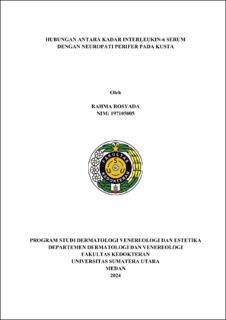Hubungan Antara Kadar Interleukin-6 Serum dengan Neuropati Perifer pada Kusta
The Relationship between Serum Interleukin-6 Levels and Peripheral Neuropathy in Leprosy

Date
2024Author
Rosyada, Rahma
Advisor(s)
Lubis, Ramona Dumasari
Yosi, Ariyati
Metadata
Show full item recordAbstract
Background: Peripheral neuropathy is the most common neurological
manifestation of leprosy. It occurs due to the body's immune system's reaction to
Mycobacterium leprae infection in the affected nerves. Interleukin-6 is a proinflammatory
cytokine that plays a role in the inflammatory process. In the nervous
system, IL-6 plays a role in the development, differentiation, regeneration, and
degeneration of nerve cells.
Objective: To determine the relationship between serum levels of IL-6 and
peripheral neuropathy in leprosy.
Subjects and Methods: This was an observational analytical study involving 33
leprosy patients with peripheral neuropathy, and 33 leprosy patients was not.
Semmes-Weinstein Monofilament test was used to determine the study subjects.
Serum IL-6 levels were assessed using enzyme-linked immunosorbent assay
(ELISA).
Results: The characteristics of leprosy patients with peripheral neuropathy were
most common in male, age group 18–25 years old and had a bacterial index of 2+.
The mean serum IL-6 levels in leprosy patients with peripheral neuropathy was
85.93±22.06. The mean serum IL-6 levels in leprosy patients without peripheral
neuropathy was 81.76±19.65. There were no significant differences in the two
groups.
Conclusion: No relationship between serum IL-6 levels and peripheral neuropathy
in leprosy.
Collections
- Master Theses [212]
